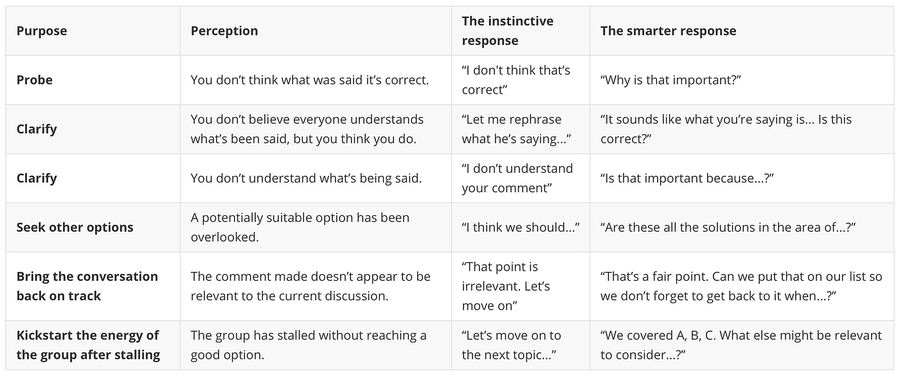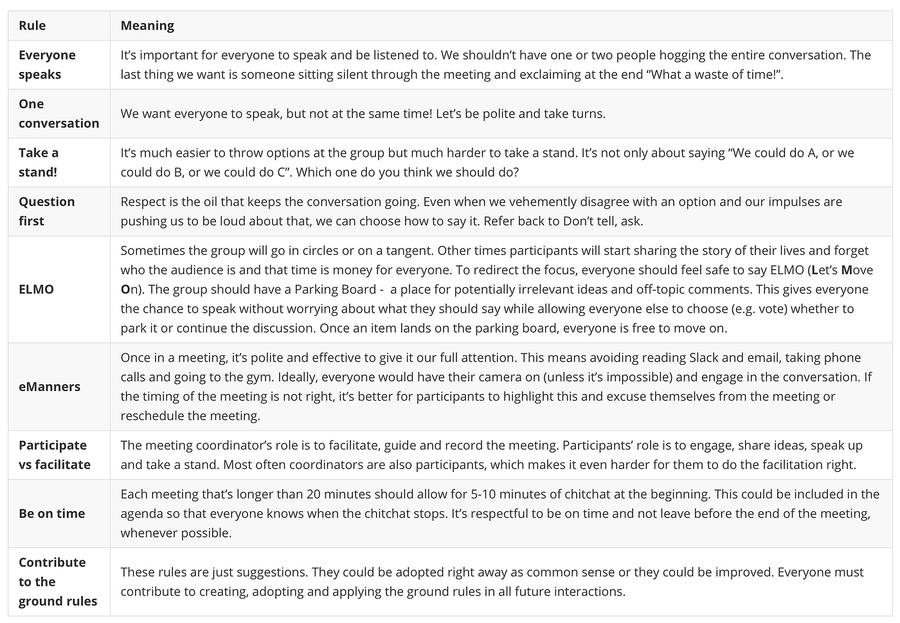Meetings
Meetings are a symptom of bad organization. The fewer meetings, the better
Our time is precious and meetings are one those toxic time killers. Many companies are adopting unconsciously a culture of meeting that gives the impression of being busy and productive. At Astrafy, we are very strict on meetings and try to have as few as possible. Our time is much better spend when we can focus on added-value tasks. The rest of this section describes our meeting culture and is largely inspired from this article.
The cost of bad meetings
Most of us can spot the telltale signs of a bad meeting from miles away. We’ve all sat in at least one “last-minute” meeting that clearly lacked purpose and preparation and was marred with confusion about participants’ roles, unclear next steps and a lack of decisive follow-through. The result: huge frustrations for everyone involved.
Given that the amount of meetings has more than doubled in the last half a century (and it’s still increasing), this potentially wasted time leaves us no choice but to work past our end of the day or even during the weekends to catch up on “productive work”. The result is a snowball of issues including burnout, cynicism and disengagement, which translate into enormously expensive problems for employers.
Aside from participants’ feelings of irritation and confusion, poorly organised meetings cost a lot of money. A recent study from 2019 by Doodle has calculated that a whopping 541 billion dollars in employee time are lost, for companies in the US, UK, Germany and Switzerland alone. Two-thirds of meetings are found to be “unnecessary” or “a waste of time”. According to the report, roughly 24 billion hours of useless meetings could be put to better use, either for better meetings or asynchronous work.

Poorly structured, badly timed and ineffectively run virtual meetings are a brain-killer. Virtual meetings require a higher degree of consideration and preparation to not be over-taxing, leading to what we now infamously called the “Zoom fatigue”. Virtual meetings also require an experienced coordinator who can guide participants through the various stages of the meeting and inspire their creativity and imagination even more than in person. Without a facilitator, a virtual group will rarely generate more than incoherent noise.
Good meetings start with great questions
Almost everything in life, meetings included, can be understood easier by asking the right questions. This is true for every stage of a meeting: preparing, starting, focusing, information-gathering and decision-making.
There are two types of questions: A Questions and B Questions. Let’s see some examples and use-cases when each type works best. Imagine a team has a meeting about improving their hiring process.
A Question: “The first thing we want to talk about are inputs. What are the inputs to our hiring process?”
B Question: “Imagine you are about to develop our team’s hiring. What information would you need to start?”
The A Question is straightforward and asks exactly what the meeting coordinator wants to know. These sorts of questions are the norm. Most of us ask them daily, on auto-pilot, because we rarely have enough time to think about what to ask and how to ask it.
The problem with this type of question is that will often lead to an awkward pause from the meeting participants, while they scratch their heads to answer something, anything. The answers will rarely have any breadth.
By contrast, B Questions are much better because they stimulate participants to imagine themselves doing the task:
It uses simple language, that everyone is familiar with
It makes it personal because it addresses them directly (“you”)
It’s action-oriented (”you’re about to”)
It’s open-ended (”what information”)
Great questions checklist
✅ Start with an image-building phrase: “Imagine that…”, “Think about…”, “Consider that…”, “What if…”
✅ Extend the image to their answer: give participants an idea of what answers are expected, to help them visualise their answers
✅ Only then, ask the A Question: once participants start visualising the answer in their heads, ask them the direct question that prompts them to respond
⚠️ Caveat
Be careful not to put the wrong image in peoples’ heads. For example: “Imagine you’re about to develop our team’s hiring process. Things go exceptionally well and your boss is so happy with the results that she decides to promote you. What information would you need to start?” This is a B Question alright, but instead of helping participants visualise the right things, you’ve now lost them in daydreaming about their upcoming promotion.
Could’ve, should’ve, would’ve
Choosing the right question verb is important in the right context. Sometimes we want to generate the maximum amount of ideas and other times we want a problem resolution or a decision for participants to buy into.

Don’t tell, ask
Once you start asking questions, the group will begin to respond. Some responses will be in line with the question, others will be unclear, and some will be irrelevant to the discussion. There’s a very strong impulse in all of us to tell people which is which…
However, let’s look at how rephrasing the answer to a question not only disarms conflicts before they start but also generates better answers.
⚠️ Caveat
There’s always a trade-off between speed and quality that applies to meetings as well.

Floating your ideas
To create ownership and buy-in, let the group create the idea/solution instead of feeding it to them. An effective decision (ED) needs the right decision (RD) with the right commitment to it (CD).
ED = RD x CD
Therefore, if you have a good option in your mind and you see that the group has overlooked it, you can float your idea but ask participants to identify its benefits and record that option in their own words.
That’s a three-part act:
State the idea as a question: “What if…?”, “What about…?”
Ask the group to identify the benefits/trade-offs: “What do you see as benefits and trade-offs?”
Ask the group to rephrase it in their own words: “How would you want me to capture this idea/decision?”
Don't book meetings without the 5Ps and 3Hs
Before you even book a meeting, ask yourself what you what people to have in their heads (knowledge), hearts (beliefs) and hands (actions, results) that they didn’t have before this meeting.
There’s a huge difference between throwing a meeting in people’s calendars hoping that you’ll figure out what to do during the meeting and scheduling meetings that have substance and will likely not leave participants tired, confused and frustrated.
The difference is preparation. A good meeting has all the 5Ps:
Purpose: the reason for this meeting, its key objectives.
Product: the outcome of this meeting, its success criteria.
Participants: who needs to be involved, their distinct perspectives
Probable issues: likely concerns and gotchas that will derail the meeting from its purpose and product
Process: the type of meeting and its agenda
Below are some questions to ask ourselves when we prepare each of the P above.

Meeting ground rule
Ground rules or group manners are a set of agreed behaviours that participants will follow when interacting with each other. People who work well together for a long time will have no problem self-correcting back to their spoken (or unspoken) ground rules. With newly formed groups it’s more challenging to start, but over time, the results will pay off.
Below are examples of ground rules to be agreed with the group.

💡Not every company will have an Agile coach to help facilitate meetings, but if you can get one and they’re good facilitators, you’ll have more time to immerse yourself as a participant and the quality of the meeting will probably be higher.
In summary, here’s a simple checklist to ask ourselves before each meeting:
✅ What do you want people to have in their heads (knowledge), hearts (beliefs) and hands (actions, results) that they didn’t have before this meeting?
✅ Does this meeting have all the 5Ps? Do I understand them? The difference between good and bad meetings is preparation (purpose, product, participants, potential issues and process). If a meeting doesn’t have it, it’s most likely to result in confusion, frustration and lost productivity.
Logistics
In case of videoconference meetings, make sure you tick the following criteria:
you are in quiet space with no background noise
you have a decent quality micro so that everyone can hear you loud and clearly
you have quality headsets or speakers
Last updated
